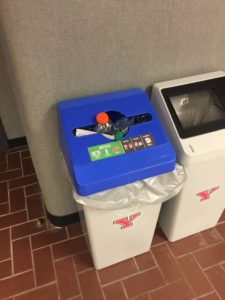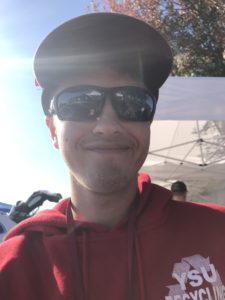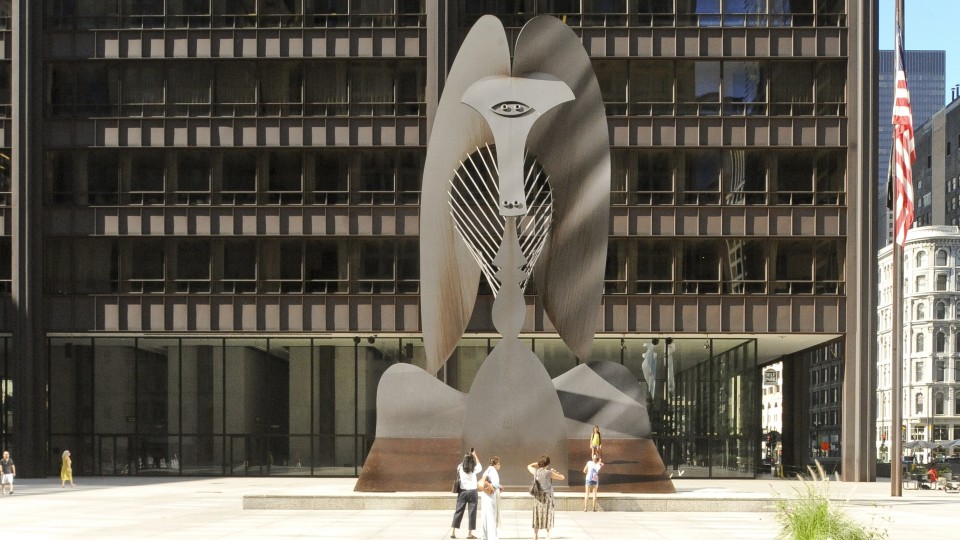Working for a College Recycling Program: David Klasovsky ’23 at Penguin Recycling
Apr 18, 2022As strange as it might seem, one of the best college recycling programs in the country resides in a rust-belt city of little modern renown. Youngstown State University has received first place for Ohio in Campus Race to Zero Waste “…for nine consecutive years; during the last 16 years, it has ranked in the top 20 nationally,” (Barron, 2022) and it was a valuable lesson in how local communities and entities can be linked with the broader recycling supply chain.
My day-to-day work was fairly simple: drive around campus to pick up recycling bags at any of the loading docks, as well as walk the buildings to clean out the bins inside. When I started, before even acquiring the training to drive the trucks we used for this, I sorted recycling in the campus warehouse by material type (mainly taking the paper out from all the plastics and aluminum cans). At least once a week, our team would gather surplus or discarded electronics from several buildings and send them to a local business- Southside Recycling- for recycling and processing. As I spent more time for the department, I became its social media manager, sharing articles and information about recycling news locally and nation-wide. Working here provided me the ability to pursue several interesting projects that my supervisor, Dan Kuzma, helped facilitate.

Stock recycling bin used in campus/academic buildings
The first was initiated with a party already affiliated with us, Southside Recycling. As the social media manager, it was a great opportunity to learn more about community recycling efforts and community building from a local business. The then-owner- Ken Greco- told me about his commitment to keeping recycled steel local to the Youngstown area, with Vallourec Steel being his primary customer. He also undertook efforts such as helping build community gardens on lots in the company’s neighborhood. Overtime, I got to see in real-time the effects of economic policy on Youngstown recycling. During the tariff disputes between China and the US, Southside Recycling was unable to take electronics most days, as the situation had, “…backed up recyclables for the foreseeable future and there is nowhere to send them… for any price” (Southside Recycling, 2019) which they relayed to the public via social media. A second project undertaken was a can-drive project done in tandem with a school club I was a member of. We collected aluminum cans during college football tailgating and delivered them to Southside Recycling where we would pay for them. This too was related to economic events, as multiple people made a point to tell me how low the prices for cans were at that period opposed to earlier years due to the trade war.
Of course, Southside was not the only entity linked to YSU recycling efforts; the sorting I conducted in my earlier work helped us send paper recycling to a paper processing company in North Lima. The Sheriff’s Department picked up electronics at the warehouse to take to the county facilities. The Green Team– the Recycling Department for Mahoning County- provided the dumpsters our team deposited the collected recyclables in. Republic Services- a waste disposal company- retrieved the college’s garbage and recycling.

Me on the job!
Local relationships in recycling weren’t the only things I learned about during my time at YSU. With Mr. Kuzma as my mentor, the job was a gateway to learning about environmental science at the ground floor. We discussed current events on recycling news, including a Guardian article on the international recycling market that exposed the egregious dumping of plastics from the US and the UK in countries like Cambodia, where unregulated processing plants wrought heavy air pollution on the populace. I also read Silent Spring during my work, and it gave me an better understanding of the interconnectivity of all life in ecology, juxtaposed with the policymaker and private sector connections that allow dangerous substances to be applied with little regulation or repercussion. Having started the job still a music major, thesis discussions, readings, and experiences all had inspired me to switch majors to environmental science while attending YSU, leading me to where I am today.
A System in Limbo: David Klasovsky ’23 at the Law Office of Phillip Brigham in Chicago, Illinois
Nov 16, 2021The first time I entered the Daley Center in downtown Chicago was a jarring experience. Not because of witnessing someone being dragged out of a courtroom screaming obscenities at the judge or seeing a heated exchange between lawyers, but rather for quite the opposite. Everything felt empty.
It was early in the morning, about 9 a.m. on a Friday, during my second week in the city. As I stood in the lobby waiting for my boss, Phillip, to arrive, I saw security scanning people through without much hassle. Someone ambled by without getting a temperature check and a guard gave a halfhearted attempt to have someone track them down but nothing came of it. I was watching a skeleton crew in action.
When Phillip joined me, we went up the elevator to the waiting area outside of a courtroom. Hardly anyone other than those involved in our case came up to our floor (I only saw a solitary janitor walk through the hallway as we sat down to wait. Phillip’s client came, we shook hands and exchanged pleasantries, and together we waited to be let inside and for opposing counsel’s arrival as, apparently, they are often late to court appearances. After getting confirmation that I was allowed inside, we all entered the courtroom. Large plastic panes stood on the counsel desks and the judge’s bench, a change I suspect will become a permanent fixture in courts from now on for many reasons.
Today was not a hearing or trial, but simply a status update on the case where motions and items would also be dealt with. Phillip’s intention was to request more items for the discovery process—a.k.a. the legal means by which lawyers obtain documentation and evidence from various entities to be logged and cataloged so that the judge knows ahead of time what is being presented during the final trial or hearing—in order to have access to important financial documents related to the case. These would be used as evidence for a deposition set to be held a few weeks after this hearing.
As the hearing commenced, I observed the “In God We Trust” lettering posted on the wall and found it slightly strange if not chilling based on everything that has taken place within the past year. Although, of course, it’s simply another feature of the court system that has been present for close to two centuries. I then turned my full attention back to the situation at hand.
Once the status was over, the clients and their lawyers met in a room off the side of the court to discuss what had occurred before parting ways. Phillip and the opposing counsel then filled out the paperwork necessary to file their motions. After chatting with the other attorney for a while, we reviewed the case and prepared for the next stages.
This was not the last time I went to the Daley Center and, as of writing this, I know I will be returning at least one more time for the same case. Though I cannot say much about the details of the case in order to protect the confidentiality of those involved, it has made it very clear that we are in the midst of a major transition in our courts, prompted by the conditions we are living under and the slow pace of return for many workers. Whether one wants to admit it or not, everything we know about the judicial structure is changing.
Photo credit: https://www.architecture.org/



